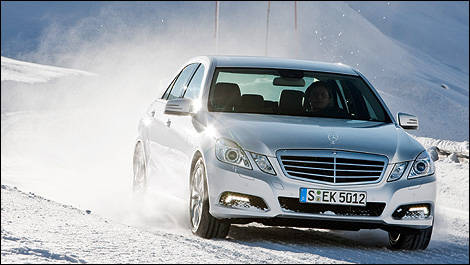As reported by Mercedes-Benz
As with the 4MATIC system's set-up on a dry or wet road, the directional stability and, therefore, the active safety of the E-Class 4MATIC models are paramount at all times when wintry conditions prevail, too. The mechanical principle of the 4MATIC system, featuring a 45:55 torque split between the front and rear axles and a multi-disc limited-slip centre differential with a basic locking torque of 50 Newton metres, offers all the right ingredients.
This basic design enables high levels of traction, firstly because the dynamic shift in axle load toward the rear axle that occurs during acceleration is harnessed to deliver more drive torque to the rear wheels. Secondly, the multi-disc differential lock is also able to shift the drive torque between the front and rear axles, varying the split between 30:70 and 70:30 as the road conditions dictate. Consequently, intervention by the ESP®, 4ETS or ASR electronic control systems can be delayed for as long as possible and the bulk of the drive torque converted into tractive power, even on slippery roads. All control system interventions go virtually unnoticed, yet drivers still know straight away if they are driving on the limit, as a yellow warning symbol will flash in the instrument cluster. This serves as a prompt to adapt the driving style to the road conditions.
The drive mechanism's permanently engaged design offers key advantages over other systems that first need to diagnose a lack of grip before activating their 4x4 technology. The 4MATIC on the E-Class will have already made use of this valuable time to start transmitting drive torque via the wheels to the road.
Kamm's Circle describes the limits of driving physics
Like any other all-wheel-drive system, the 4MATIC on the E-Class has to abide by the laws of driving physics, whose interrelations are clearly illustrated in what is known as the "Kamm's Circle". The fundamental rule is that a tyre is only able to transfer a certain level of overall force to the road surface. If a particularly high degree of longitudinal force is required during acceleration or braking, for example, the available lateral force is reduced. When cornering, the reverse applies: now a large amount of lateral force is required to keep the vehicle on course, while the longitudinal force potential is restricted. The engineers' skill in designing the drive mechanism and fine-tuning the control systems lies in their ability to exploit these correlations in such a way as to ensure the best possible handling characteristics under all conditions. The frictional coefficient µ describes the physical grip between the tyres and the road surface. This figure is high on a dry road (µ = 0.9) and low on a snow-covered road (µ = 0.3).
As with the 4MATIC system's set-up on a dry or wet road, the directional stability and, therefore, the active safety of the E-Class 4MATIC models are paramount at all times when wintry conditions prevail, too. The mechanical principle of the 4MATIC system, featuring a 45:55 torque split between the front and rear axles and a multi-disc limited-slip centre differential with a basic locking torque of 50 Newton metres, offers all the right ingredients.
 |
This basic design enables high levels of traction, firstly because the dynamic shift in axle load toward the rear axle that occurs during acceleration is harnessed to deliver more drive torque to the rear wheels. Secondly, the multi-disc differential lock is also able to shift the drive torque between the front and rear axles, varying the split between 30:70 and 70:30 as the road conditions dictate. Consequently, intervention by the ESP®, 4ETS or ASR electronic control systems can be delayed for as long as possible and the bulk of the drive torque converted into tractive power, even on slippery roads. All control system interventions go virtually unnoticed, yet drivers still know straight away if they are driving on the limit, as a yellow warning symbol will flash in the instrument cluster. This serves as a prompt to adapt the driving style to the road conditions.
The drive mechanism's permanently engaged design offers key advantages over other systems that first need to diagnose a lack of grip before activating their 4x4 technology. The 4MATIC on the E-Class will have already made use of this valuable time to start transmitting drive torque via the wheels to the road.
Kamm's Circle describes the limits of driving physics
Like any other all-wheel-drive system, the 4MATIC on the E-Class has to abide by the laws of driving physics, whose interrelations are clearly illustrated in what is known as the "Kamm's Circle". The fundamental rule is that a tyre is only able to transfer a certain level of overall force to the road surface. If a particularly high degree of longitudinal force is required during acceleration or braking, for example, the available lateral force is reduced. When cornering, the reverse applies: now a large amount of lateral force is required to keep the vehicle on course, while the longitudinal force potential is restricted. The engineers' skill in designing the drive mechanism and fine-tuning the control systems lies in their ability to exploit these correlations in such a way as to ensure the best possible handling characteristics under all conditions. The frictional coefficient µ describes the physical grip between the tyres and the road surface. This figure is high on a dry road (µ = 0.9) and low on a snow-covered road (µ = 0.3).
 |


